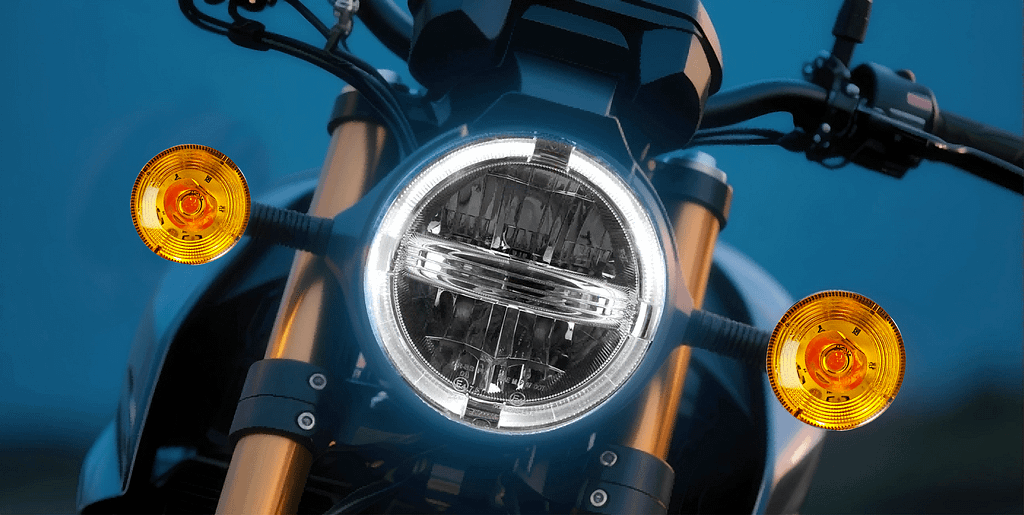A professional analysis of core technologies and functions


LED headlights have gradually replaced halogen lamps due to their high efficiency, energy savings, and adjustable brightness advantages, becoming the mainstream of two-wheeler lamps. Engineers focused on three aspects at the heart of LED headlights: “light source optimization”, “optical control” and “stable operation”.
1. Light source core : LED chip and power control technology
The brightness and stability of two-wheeled LED headlights come from LED chip technology. Currently, manufacturers adopt two mainstream chip solutions: SMD (surface mount) and COB (chip integration). SMD chips have 0.5-1W single power; engineers combine multiple ones to reach 300-500 lumens, fitting commuter two-wheelers. COB chips integrate microchips in one package: single modules hit 10-20W power and over 3000 lumens brightness, making them top choice for off-road/long-distance two-wheelers.
Manufacturers equip high-quality LED headlights with a constant current driver chip. This chip controls current fluctuation within ±5%. Even if vehicle voltage fluctuates (12V-80V) during acceleration/deceleration, it still maintains stable brightness. This avoids flickering and dimming that affect sight. Data shows: 20W COB module LED headlights use only 1/3 the power of same-brightness halogen lamps. This makes them especially suitable for electric vehicles worried about range.
2. Optical design : light cutting and lens technology
First, reasonable optical design is key to LED headlights being “bright but not dazzling.” Specifically, manufacturers equip regular products with a “stepped light type” design. Engineers divide light into upper and lower zones via reflective bowls or lenses: the upper zone has brightness ≤ 500 lumens (to avoid dazzling oncoming vehicles), while the lower zone concentrates brightness on the 15-25 meter road surface. This forms a clear “light-dark cut-off line.”
Besides, lens material and structure further optimize the lighting effect. PC (polycarbonate) lenses have over 90% light transmittance and strong impact resistance. This makes them suitable for bumpy riding environments. Manufacturers use bi-optical lenses in some high-end models. These lenses switch low/high beams via the built-in lens. For low beam, the lens shade blocks the upper half of light. For high beam, brightness jumps 40% instantly and illumination reaches over 35 meters. This eliminates the need to install an extra high beam module.
3. Heat dissipation system : the key technology to ensure life
About 70% of the energy is converted into heat when the LED chip is working, and if the heat dissipation is not done in time, it will cause the chip to decay (decrease in brightness) or even burn out. The mainstream of two-wheeled LED headlights adopts the “three-dimensional heat dissipation” scheme:
Substrate heat dissipation: The light board uses a 1.5mm thick aluminum substrate, and the thermal conductivity coefficient reaches 200W/(m・K), which is 10 times that of ordinary PCB boards.
Structural heat dissipation: The lamp body is designed with honeycomb heat dissipation holes to increase the contact area with the air, and the airflow can quickly take away heat when riding.
Active heat dissipation: The model with a power ≥ 15 watts is equipped with a micro silent fan with a speed of 3000 rpm, which can control the temperature of the lamp body within 60°C, ensuring that the LED chip life is stable up to 50,000 hours (about 5 years of daily use).
4. Scene functions and performance indicators
In functional design, manufacturers focus two-wheeler LED headlights on riding practicality. Basic models have three modes: “low beam-high beam-flash” with 10Hz frequency, to quickly warn surrounding vehicles in emergencies. Smart models add a new light sensor: it turns on lights automatically when ambient brightness is below 150 lux (dusk/tunnel) and off when above 500 lux (daytime), avoiding hazards from forgetting to switch lights.
Key performance indicators must meet cycling needs. First, for brightness: users choose 500-1000 lumens for commuting and over 2000 lumens for off-road. Then, for color temperature: manufacturers strictly control it at 3000K-6000K (national standard upper limit) – 3000K warm white penetrates rain/fog well, while 5000K positive white ensures clearer night vision. Finally, for waterproof level: it’s at least IPX6 (resists violent water spray); some outdoor models get upgraded to IPX7 (short-term immersion), so they handle heavy rain and waterlogged roads easily.
Overall, two-wheeler LED headlight tech iterates around “safety adaptation” – from chips to heat dissipation, and light type to function. In turn, understanding these professional details helps cyclists do two things: first, avoid inferior “high-brightness but poor-light” products; second, choose accurately based on their own riding scenarios. This makes night riding safer and more secure.


0 Comments